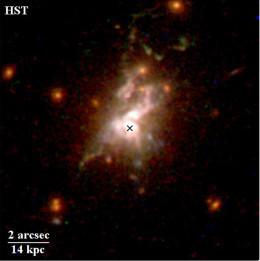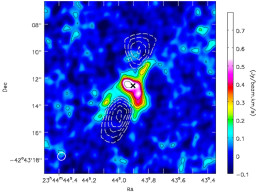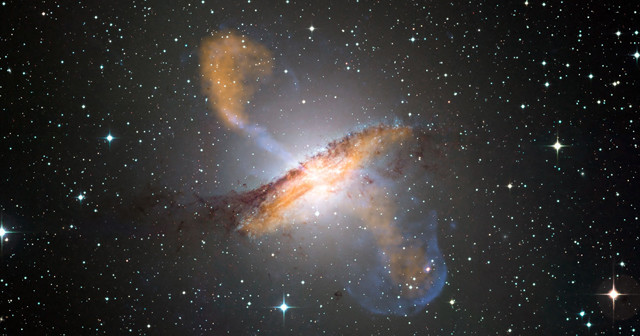We believe that supermassive black holes evolve in tandem with their host galaxies — but how do the two communicate? Observations from the Atacama Large Millimeter/submillimeter Array (ALMA) have revealed new clues about how a monster black hole talks to its galaxy.

A Hubble image of the central galaxy in the Phoenix cluster. [Adapted from Russell et al. 2017]
Observing Feedback
Active galactic nuclei (AGN), the highly luminous centers of some galaxies, are thought to radiate due to active accretion onto the supermassive black hole at their center.
It’s long been suspected that the radiation and outflowing material — which often takes the form of enormous bipolar radio jets emitted into the surroundings — influence the AGN’s host galaxy, affecting star formation rates and the evolution of the galaxy. This “AGN feedback” has been alternately suggested to trigger star formation, quench it, and truncate the growth of massive galaxies.
The details of this feedback process, however, have yet to be thoroughly understood — in part because it’s difficult to obtain detailed observations of how AGN outflows interact with the galactic gas surrounding them. Now, a team of scientists led by Helen Russell (Institute of Astronomy in Cambridge, UK) has published the results of a new, high-resolution look at the gas in a massive galaxy in the center of the Phoenix cluster.
Many Uses for Fuel
The Phoenix cluster, a nearby (z = 0.596) group of star-forming galaxies, is the most luminous X-ray cluster known. The central galaxy in the cluster is especially active: it hosts a starburst of 500–800 solar masses per year, the largest starburst found in any galaxy below a redshift of z = 1.
The star formation in this galaxy is sustained by an enormous reservoir of cold molecular gas — roughly 20 billion solar masses’ worth. This reservoir also powers the galaxy’s central black hole, fueling powerful radio jets that extend into the hot atmosphere of the galaxy and blow a giant bubble into the hot gas at each pole.

ALMA observations of the molecular gas in the central galaxy of the Phoenix cluster. The bubbles blown by the radio jets are indicated by the dashed white contours. Extended filaments of molecular gas can be seen to wrap around these cavities. [Adapted from Russell et al. 2017]
ALMA Spots Filaments
ALMA’s observations of this reservoir show that extended filaments of molecular gas wrap around the peripheries of the radio bubbles. These filaments span 10–20 kpc (~30–60 thousand light-years) and have a mass of several billion solar masses. The velocity gradients along them are smooth, suggesting that the gas is moving in an ordered flow around the bubble.
Russell and collaborators suggest that these observations indicate that the clouds of molecular gas were either lifted by the radio bubbles as they inflated, or they formed in place via instabilities caused by the inflating bubbles.
Either way, the data provide clear confirmation that the jets from the black hole affect the location and motion of the cold gas in the surrounding galaxy. This is a beautiful piece of direct evidence showing how supermassive black holes might be communicating with their galaxies.
Citation
H. R. Russell et al 2017 ApJ 836 130. doi:10.3847/1538-4357/836/1/130

5 Comments
Pingback: ALMA observes SMBH interactions with host galaxies
Pingback: Buchi neri e interazione con la galassia ospite | Accademia delle Stelle
Pingback: ALMA explora cómo hablan los agujeros negros supermasivos con sus galaxias – Observatori Astronòmic
Pingback: Núcleos galácticos activos « SEDA / LIADA - RedLIADA - Cursos LIADA - Cielo del Mes - Fenómenos Astronómicos - RELEA
Pingback: Marzo 2017 – Observatori Astronòmic